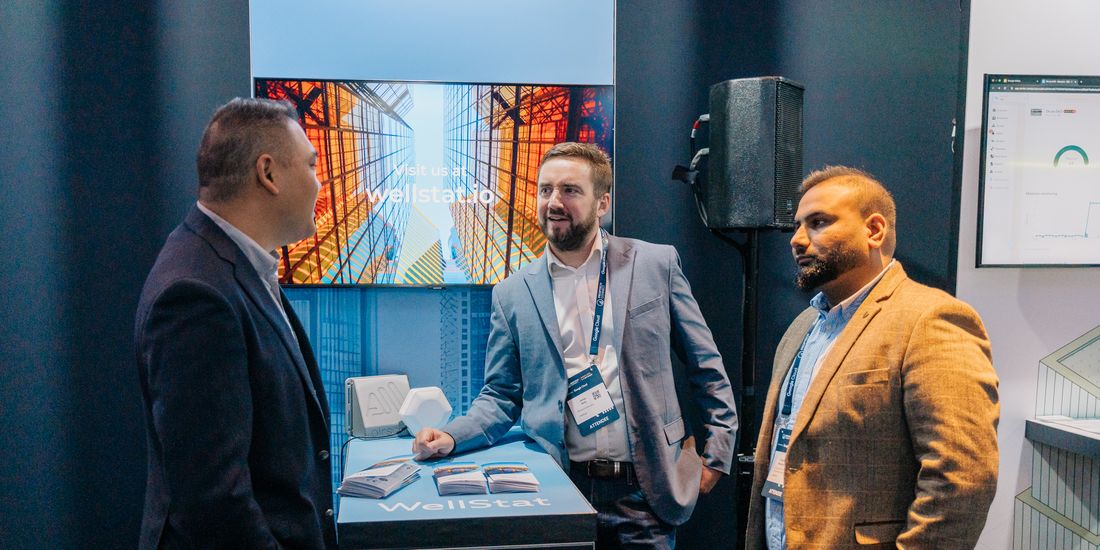IWBI sat down with Kashif Mughees, a smart buildings leader working at the intersection of sustainability and health
NORTHAMPTON, MA / ACCESS Newswire / October 20, 2025 / By Jason Hartke, Ph.D.
With over a decade of experience in the smart buildings industry, Kashif Mughees, who leads commercial and partnerships at WellStat, has built a career on turning complex energy and environmental challenges into opportunities for organizations to embrace solutions that yield powerful economic benefits. An engineer by training, Kashif's work stands at the intersection of technology, data and human impact, partnering with leaders from across the public and private sectors to apply innovative solutions that advance energy security, environmental performance and healthier indoor spaces.
At its core, WellStat is helping reshape what it means to manage building performance, leveraging intelligent energy solutions and building analytics to help businesses achieve healthier, smarter and more sustainable spaces. The company's approach combines industry knowledge with real-time insights and IoT analytics, improving operational performance while helping organizations optimize for health.
Kashif has been at the heart of this work, driven by a passion for sustainable energy management, cross-sector collaboration, and data-driven innovation. We sat down with him to learn more about the work WellStat is leading and how the company is addressing today's most pressing challenges and empowering market leaders to champion health, sustainability, and long-term business resilience.
Q: How do you see the relationship between energy efficiency and indoor air quality evolving and what kind of synergies should the industry be driving to advance both?
For too long, energy efficiency and indoor air quality have been treated as trade-offs: save energy or improve comfort. Today, we have the tools and intelligence to achieve both.
In my experience, fine-tuning building systems through real-time insights can reduce waste and maintain healthy air at the same time. For example, in one project, simply adjusting HVAC start times cut energy use without affecting comfort. In another, tracking indoor air quality helped uncover efficiencies that, once fixed, improved both ventilation and performance. Demand Control Ventilation is a great example of this synergy in action, using live occupancy and air quality data to optimize airflow, reduce energy consumption, and maintain healthier environments.
It's important to stop treating health and efficiency as separate goals and start measuring how they work together to improve overall building performance.
Q: From your perspective, what is the business case for investing in buildings that prioritize health, well-being and sustainability? How do you communicate that to organizations you work with?
The value is clear. Healthier buildings are higher performing assets. They attract and retain talent, reduce operational risk and strengthen long-term value.
I often say, if you can measure it, you can prove it, and if you can prove it, you can scale it. That is where data comes in. When leaders see tangible results such as improved air quality, reduced energy costs and greater occupant satisfaction, the conversation shifts from compliance to commercial advantage.
Even in residential developments, we are seeing growing interest in WELL-aligned design and monitoring. Healthier air, balanced humidity and thermal comfort reduce risks associated with damp and mould, while improving overall indoor quality and occupant well-being. These improvements do not just make homes healthier; they protect asset value, reduce maintenance costs and strengthen community trust.
Ultimately, prioritizing health delivers value for occupants while supporting long-term financial performance.
Q: Many organizations face difficulties in implementing these building strategies, such as cost constraints or new technology adoption. What are some of the biggest challenges you see in the field today and how are you working with stakeholders to overcome them?
The challenge is usually not the technology. It's getting different teams aligned. Facilities, sustainability and finance teams often have different success metrics. Our job is to connect those dots through shared outcomes.
We typically start small with a pilot project that proves measurable impact. Once the data speaks for itself, adoption accelerates across the portfolio. For example, demonstrating how small operational changes can lead to both lower energy costs and better IAQ helps shift the mindset from "new cost" to "new value."
By focusing on visibility, evidence and shared success metrics, we help organisations move from good intentions to scalable results.
Q: As the demand for healthy buildings continues to grow, how is WellStat helping demonstrate the value proposition and where do you see the strongest market drivers helping build momentum?
WellStat is helping organisations quantify what matters most, the measurable link between healthier spaces, operational performance and financial outcomes.
Our analytics platform captures real-time data on air quality, energy and environmental performance, turning it into clear, actionable insights. That enables leaders to demonstrate, not just declare, that their spaces are healthier and more efficient.
Momentum is building across sectors:
• Corporate real estate leaders are investing to attract and retain talent.
• Developers and owners see WELL as a differentiator in competitive markets.
• Investors are demanding transparency and data-backed proof of impact.
We are moving into an era where sustainability, health and performance are one conversation, and the organisations that understand that will lead the market.
View original content here.

View additional multimedia and more ESG storytelling from International WELL Building Institute (IWBI) on 3blmedia.com.
Contact Info:
Spokesperson: International WELL Building Institute (IWBI)
Website: https://www.3blmedia.com/profiles/international-well-building-institute
Email: info@3blmedia.com
SOURCE: International WELL Building Institute (IWBI)
View the original press release on ACCESS Newswire:
https://www.accessnewswire.com/newsroom/en/business-and-professional-services/iwbi-signature-interview-series-leveraging-analytics-to-propel-h-1089371
